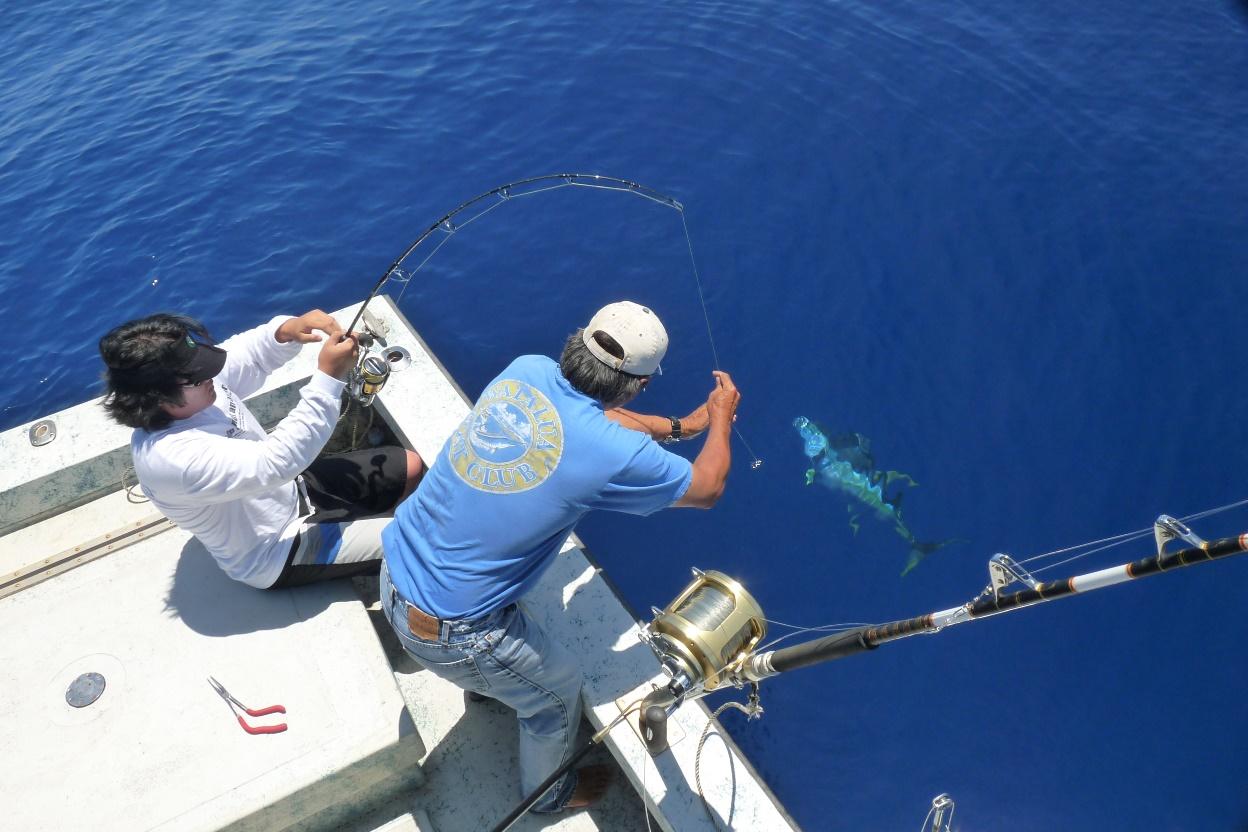Social and Economic Survey of Hired Captains and Crew in
Social and Economic Survey of Hired Captains and Crew in Commercial Fisheries
0648-0636 Social and Economic Survey of Hired Captains and Crew in Pacific Islands Commercial Fisheries
Social & Economic Survey of Hired Captains & Crew in Commerical Fisheries
OMB: 0648-0636
File Name: PIC PROTOCOL_8.16.24 (updated 8.19.24)
Social and Economic Survey of Hired Captains and Crew in Pacific Islands Commercial Fisheries

FREQUENTLY ASKED QUESTIONS (FAQS)
What is the purpose of the survey?
This survey is an effort by the NOAA Fisheries Pacific Islands Fisheries Science Center to assess the current social and economic conditions of commercial fishing crews (including hired captains) in the Pacific islands for which little is known. Although this will be the first time the Pacific Islands Fisheries Science Center conducts this survey, it has been conducted twice for Northeast states and once for Southeast states. Subsequent surveys will allow for comparisons to determine how and why commercial crew working conditions may have changed over time. Data to be collected include demographic information on crew, wage calculations systems, well-being, fishing practices, job satisfaction, job opportunities, and attitudes toward fisheries management.
Why does your participation matter?
We simply do not know much about the experiences of commercial fishing crewmembers and yet they are a critical part of the commercial fishing industry. The majority of economic and social information collected has tended to focus on vessel owners. The results of this survey will not only help fisheries managers understand what is going on in crew members’ lives but also the impacts of management decisions on commercial crew. Your participation is extremely valuable in helping improve and shape fishery management decisions.
What type of information is being collected?
Social and economic information will be collected from commercial crew. Examples of information collected on the survey include: demographic information, job opportunities, job satisfaction, wage system calculations, and well-being.
Who are we asking to participate?
Survey participants include commercial crew in the Pacific Islands. Commercial crew (including hired captains) active in Hawaii will be sampled from the State of Hawaii commercial marine license database. In the U.S. territories of American Samoa, Guam, and the Commonwealth of the Northern Mariana Islands, since there is no database of registered crew, participants will be intercepted on the docks at major ports.
Who is conducting this survey?
NOAA Fisheries Pacific Islands Fisheries Science Center is conducting this survey. We conduct applied economic and sociocultural research on the management of commercial and recreational fisheries. It is our commitment to perform independent, relevant, and accessible research aimed at providing useful input to the decision-making process in fisheries management.
When is this survey being conducted?
The survey will begin within three years and will last approximately three-four months.
How long will this survey take?
The survey will take approximately 15-20 minutes to complete. However, times may vary.
How do I benefit from participating?
Information you share will be anonymous and combined with data from other respondents. It will be used, in aggregate form, in an assessment to evaluate the current social and economic conditions of commercial fishing crews.
How will I be sure my data is anonymous?
Data collected will be kept anonymous and will not be released for public use except in aggregate statistical form without identification as to its source. Participation or lack of participation in the survey will remain anonymous. All economic data will be aggregated into statistical form for all reports.
If you have any questions, contact:
Pacific Islands Fisheries Science Center
Justin Hospital
(808) 725-5399
Interviewer’s
Name: OMB Control No. 0648-0636
Date: Expiration
Date: XX/XX/202X
Port
Name:
Start
Time:
End
Time:
Social
and Economic Survey of Hired Captains and Crew in Pacific Islands
Commercial Fisheries





Public reporting burden for this collection of information is estimated to average 15 minutes per response, including the time for reviewing instructions, searching existing data sources, gathering and maintaining the data needed, and completing and reviewing the collection of information. Send comments regarding this burden estimate or any other suggestions for reducing this burden to Justin Hospital, Pacific Islands Fisheries Science Center, (808) 725-5399, [email protected].
Notwithstanding any other provisions of the law, no person is required to respond to, nor shall any person be subjected to a penalty for failure to comply with, a collection of information subject to the requirements of the Paperwork Reduction Act, unless that collection of information displays a currently valid OMB Control Number.

In this survey, please tell us about your fishing in the last year.
The information you provide will remain private and you will not be identified with your answers.
1.1 Are you currently working as a hired captain or hired crewmember, full time or part time, on one or more commercial fishing vessels?
1. Yes
2. No (discontinue interview)
1.2. What fisheries do you target? Of these, which do you consider your primary fishery in terms of income?
-
Pacific Islands Region
Commercial Fisheries
Check ALL That
Apply
Primary Fishery
(Check ONE Only)
State of Hawaii
Pelagic:
Trolling


Handline


Hawaii Offshore Handline


Ika Shibi/Palu Ahi


Deep 7 Bottomfish


Uku


Crustaceans:
Kona Crab


Deepwater Shrimp


Ecosystem Component Species:
akule or opelu


Nearshore species (menpachi, ta’ape, kahala)


Reef-affiliated species (uhu, kumu, kala, palani, manini)


Lobsters (spiny, green spiny, slipper)


American Samoa / Guam / CNMI
Pelagic:
Trolling


Handline


Bottomfish Management Unit Species
Deep water (depth >500 ft.)


Shallow water (depth < 500 ft.)


Reef-affiliated species:
Hook and line


Spearfishing


Throw Net


1.3. Approximately how many days at sea did you spend working in each one of these fisheries in the past year?
Primary fishery name: _______________________________ Days at sea per year: _________________
Next fishery name: _________________________________ Days at sea per year: _________________
Next fishery name: _________________________________ Days at sea per year: _________________
1.4. In the last year, did you also work as a hired crew member in the recreational for-hire fishing industry (charter boat/ head boat/ party boat/ fishing guide)?
a. YES
b. NO
1.5. On your primary vessel, with what type of contract were you employed?
a. Independent contractor (receive 1099 MISC for taxes)
b. Full-time employee (receive W-2 for taxes)
c. Other: _____________________________________________
1.6. Do you have any other formal qualifications, including licenses, certificates or training, related to your commercial fishing activities?
a. Yes (Specify):___________________________________________________________
b. No
1.7. Where is your primary place of residence?
State:_____________ Zip
Code:
_______________
What port did you primarily work out of in the last year?
Port State Country
Are any members of your family (for example, parents, children, siblings, uncles/aunts, cousins, in- laws) involved in commercial fishing or other fishing-related activities (for example, book-keeping, provisioning vessels, marketing)?
YES
NO
How long have you been involved in commercial fishing? If less than a year, how many months?
YEARS
MONTHS
How many generations of your family have fished commercially including yourself?
Generations
Within
your
primary fishery, consider the vessel you worked on the most in the
last year.
Please
answer the following questions based on your fishing activities on
that primary vessel.
What was the main port of landing for that vessel in the last year?
Port State Country
How many days (24 hour periods) does a typical trip last before returning to port?
_Days
What was the average size of the crew in the last year (including the captain)?
Members
How many hours per day (24 hour period) did you usually work while on a fishing trip?
Hours
Was the vessel you worked on most in the last year owner-operated? (Please circle one response).
YES
NO
DON’T KNOW
In
the following questions please tell us how revenues and expenses are
distributed amongst crew.
For your current vessel, how were you paid?
A share system: revenues and expenses were shared between the boat and crew (CONTINUE)
Other (e.g., per trip, hourly), please specify: (SKIP TO Q14)
For share systems, what were the typical percentages distributed to the boat (the vessel owner) and crew?
% Boat (owner) share
% Crew share
Don’t Know
For share systems, which trip expenses were usually deducted? (CHECK ALL THAT APPLY)
Fuel/Oil
Ice
Fishing quota or days-at-sea
Food
General fishing supplies (hooks, bags, totes, gloves, etc.)
Bait
Other
In
the following questions, please tell us about your fishing
activities and employment on your primary vessel.
What was your position on the vessel in the last year? (CHECK ALL THAT APPLY).
Captain
Deck hand
Engine mechanic
Cook

Other (please specify):
Which of the following was the first crew position you ever had when you began fishing?
Captain
Deck hand
Engine Mechanic
Cook
Other (please specify):
How were you hired for the vessel you currently work on? (CHECK ONE RESPONSE)
Word of mouth
Referred by a friend
Related to owner
Related to non-owner crew member (may include hired captain)
Previous work with the same vessel
Advertisement
Other
How difficult was it for you to find employment on your vessel? (CHECK ONE RESPONSE)
Very easy
Easy
Neither easy nor difficult
Difficult
Very difficult
As of today, how many years have you worked on your primary vessel?
Years
Months
How many different vessel owners did you work for in the last year?
Vessel owners
About how many miles do you travel from where you live to where your primary vessel docked for the past year? (Please circle only one response).
Miles
In the following questions, please tell us how you feel about the regulations and management process in your primary fishery.

Please indicate the extent to which you agree or disagree with the following statements regarding the rules and regulations in your primary fishery. (CHECK ONE RESPONSE PER ITEM)
-
Strongly Disagree
Disagree
Neutral
Agree
Strongly Agree
a. The rules and regulations change so quickly it is hard to keep up.
1
2
3
4
5
b. The fines that are associated with breaking the rules and regulations of my primary fishery are fair.
1
2
3
4
5
c. I feel that the regulations in my primary fishery are too restrictive.
1
2
3
4
5
Have you ever participated in any aspect of federal fisheries management (such as attending meetings, writing letters, or serving on a committee)?
YES (CONTINUE)
NO (SKIP TO Q24)
In the following questions, we are interested in commercial fishing as a lifestyle and how satisfied you are.

Please indicate the extent to which you agree or disagree with the following statements about fishing as a career. (CHECK ONE ITEM PER RESPONSE)
-
Strongly Disagree
Disagree
Neutral
Agree
Strongly Agree
a. Fishing is just a job to me.
1
2
3
4
5
b. Leaving the fishing industry is something that I have considered.
1
2
3
4
5
Would you advise a young person to enter fishing?
YES
NO WHY?___________________________________________________________________________________________________________________________
___________________________________________________________________________________________________________________________________
Would you still be a commercial fisherman if you had your life to live over?
YES
NO WHY?___________________________________________________________________________________________________________________________
___________________________________________________________________________________________________________________________________
26. How satisfied or dissatisfied are you with the following items relating to the job of fishing? (CHECK ONE ITEM PER RESPONSE)
-
Extremely dissatisfied
Somewhat dissatisfied
Neither satisfied or dissatisfied
Somewhat satisfied
Extremely satisfied
a.
Your actual earnings
1
2
3
4
5
b.
The predictability of your earnings
1
2
3
4
5
c.
Job safety (e.g. physical risks to you from working as a fisherman)
1
2
3
4
5
d.
The amount of time spent away from home
1
2
3
4
5
e.
Physical fatigue of the job
1
2
3
4
5
f.
Healthfulness of the job (e.g how your job as a fisherman may impact your physical and mental health)
1
2
3
4
5
g.
Adventure of the job
1
2
3
4
5
h.
Challenge of the job
1
2
3
4
5
i.
Opportunity to be your own boss
1
2
3
4
5
27. In general, how satisfied are you with: (CHECK ONE ITEM PER RESPONSE)
-
Extremely dissatisfied
Somewhat dissatisfied
Neither satisfied or dissatisfied
Somewhat satisfied
Extremely satisfied
a. Your life
1
2
3
4
5
b. Your physical health
1
2
3
4
5
c. The overall health of the marine environment
1
2
3
4
5
In
the following questions, please tell us about any health insurance
you may have.
28. Did you have health insurance in the last year?
YES (CONTINUE)
NO (SKIP TO Q31)
29. Where did the insurance come from?
From my employer (the vessel owner)
From another employer I have
Spouse’s/Partner’s place of employment
Own Private Insurance
Federal or State Insurance Program
Other
In
the following questions, we are interested in gathering demographic
and economic data about crew.
30. What is your race and/or ethnicity? Select all that apply and enter additional details in the spaces below.
. American Indian or Alaska Native – Enter, for example, Navajo Nation,
Blackfeet Tribe of the Blackfeet Indian Reservation of Montana, Native Village of Barrow Inupiat Traditional Government, Nome Eskimo Community, Aztec, Maya, etc.
Asian – Provide details below.
¨ Chinese Asian Indian Filipino
¨ Vietnamese Korean Japanese
Enter, for example, Pakistani, Hmong, Afghan, etc.
¨ Black or African American – Provide details below.
¨ African American Jamaican Haitian
¨ Nigerian Ethiopian Somali
Enter, for example, Trinidadian and Tobagonian, Ghanaian, Congolese, etc.
¨ Hispanic or Latino – Provide details below.
¨ Mexican Puerto Rican Salvadoran
¨ Cuban Dominican Guatemalan
Enter, for example, Colombian, Honduran, Spaniard, etc.
Middle Eastern or North African – Provide details below.
¨ Lebanese Iranian Egyptian
¨ Syrian Iraqi Israeli
Enter, for example, Moroccan, Yemeni, Kurdish, etc.
Native Hawaiian or Pacific Islander – Provide details below.
¨ Native Hawaiian Samoan Chamorro
¨ Tongan Fijian Marshallese
Enter, for example, Chuukese, Palauan, Tahitian, etc.
White – Provide details below.
¨ English German Irish
¨ Italian Polish Scottish
Enter, for example, French, Swedish, Norwegian, etc.
In
the following questions, we are interested in gathering demographic
and economic data about crew.
31. What is your age? __________________
32. Gender: (Select all that apply)
Female
Male
Transgender, non-binary, or another gender
Prefer not to answer
33. 3hat is the primary language you speak at home?
34. Where were you born?
U.S.: State
Outside U.S.: Country
35. What is your marital status?
Married
Widowed
Divorced
Separated
Never Married
Living with an unmarried partner
36. How many people lived in your primary household in the last year?
Adults and children under 18
37. Which category best describes the highest level of education that you have completed? (Please circle one response).
Did not complete high school; indicate highest grade completed:
High school diploma/equivalency
Associate’s/ two year degree
Bachelor’s/ four year degree
Graduate degree
38. What percentage does fishing contribute to your annual household income?
% (If 100% SKIP to Q 41)
39. If you have other sources of household income besides fishing, please list the top three most important sources of income other than fishing for your household.
|
Source |
Most important |
|
2nd most important |
|
3rd most important |
|
40. What was your annual fishing income in the last year?
1. Less than $10,000
2. $10,000 - $19,999
4. $30,000 - $39,999
5. $40,000 - $49,999
6. $50,000 - $59,999
7. $60,000 - $69,999
8. $70,000 - $79,999
9. $80,000 - $89,999
10. $90,000 - $99,999
11. $100,000 - $119,999
12. $120,000 or more
41. Is there anything else you would like to tell us that you think fisheries managers should know about?
______________________________________________________________________________________
______________________________________________________________________________________________________________________________________________________________________________
Your contribution to this effort is greatly appreciated. Thank you
| File Type | application/vnd.openxmlformats-officedocument.wordprocessingml.document |
| Author | Matthew Cutler |
| File Modified | 0000-00-00 |
| File Created | 2024-09-13 |
© 2025 OMB.report | Privacy Policy